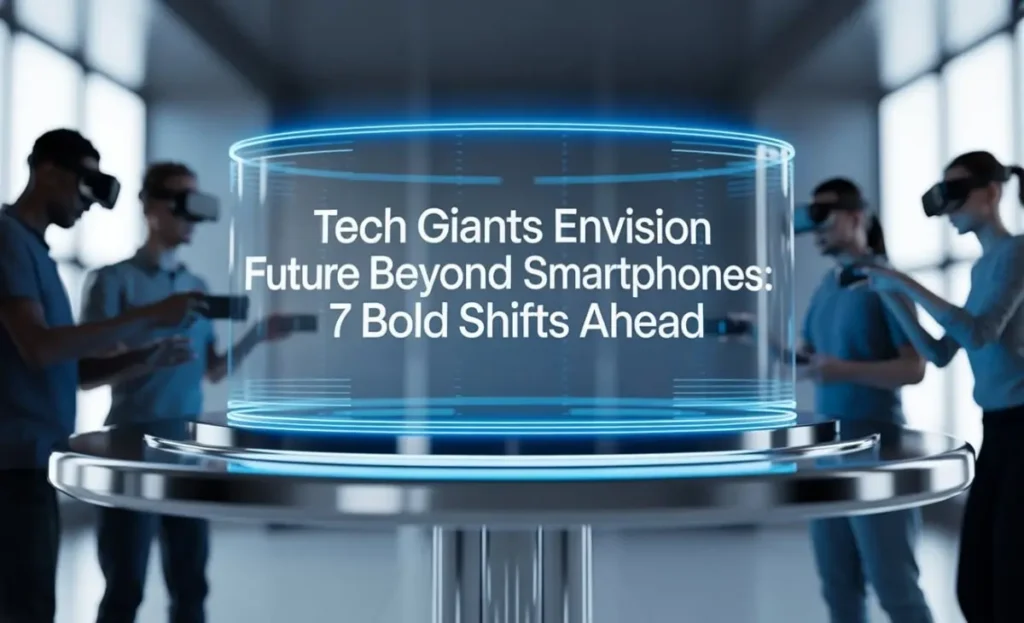For more than a decade, smartphones have been the centerpiece of our digital lives. They’ve replaced cameras, calculators, alarm clocks, and even wallets. But technology leaders are already setting their sights on what’s next. When tech giants envision future beyond smartphones, they’re imagining an era where devices disappear into the background, where technology blends seamlessly with daily life, and where artificial intelligence powers personalized, context-aware experiences. This is not just about replacing the phone — it’s about redefining how humans interact with the digital world.
The shift is important because it signals the beginning of a post-smartphone era. As users, we’ve grown accustomed to touchscreens, app stores, and constant connectivity. But emerging technologies suggest that in the next decade, screens may shrink, vanish, or move to places we’ve never imagined. Instead of pulling a phone from your pocket, you might glance at smart glasses, speak to an AI assistant embedded in your earbuds, or even interact with holograms floating in your living room.
What Does a Future Beyond Smartphones Mean?
A future beyond smartphones doesn’t simply mean giving up mobile devices. It means a technological transition to systems that are more intuitive, immersive, and invisible. This future leans heavily on innovations like augmented reality (AR), virtual reality (VR), mixed reality (MR), wearables, AI-driven assistants, and brain-computer interfaces.
These tools aim to eliminate the need for a single rectangular device and instead create a mesh of connected, context-aware gadgets that serve you proactively. In short, the interface shifts from the palm of your hand to the space around you.
Why Tech Giants Are Moving Beyond Smartphones
Major companies such as Apple, Google, Meta, Microsoft, and Samsung are no longer content with incremental smartphone upgrades. The market is saturated, and the pace of innovation in smartphones has slowed. Foldable screens and improved cameras are impressive but not transformative.
The next growth wave lies in immersive computing and natural interactions. Tech giants are competing to own the platforms, ecosystems, and experiences that will define the next era — just as the iPhone defined the 2010s. For them, controlling the “tech giants envision future beyond smartphones” world is about securing user engagement, platform dominance, and revenue streams for decades to come.
Key Technologies Leading the Shift Beyond Smartphones
The move away from smartphones is powered by several emerging technologies working in synergy. Each one addresses a different aspect of user interaction and digital integration.
Augmented Reality and Mixed Reality
AR and MR overlay digital information onto the real world. Apple’s Vision Pro, Microsoft’s HoloLens, and Meta’s AR glasses are designed to project interactive visuals into your environment. Instead of tapping on apps, you’ll interact with floating windows, immersive 3D objects, and live holographic conversations.
Artificial Intelligence Assistants
AI assistants like Siri, Google Assistant, and ChatGPT are evolving into proactive digital companions. In the post-smartphone world, they’ll not just respond to commands — they’ll anticipate needs, suggest actions, and carry out tasks without explicit input.
Wearables and Smart Accessories
Smartwatches, earbuds, and fitness bands are already chipping away at smartphone dependency. Future wearables will feature richer displays, biometric tracking, real-time translation, and AI processing — effectively becoming mini-smartphones worn on the body.
Brain-Computer Interfaces
Companies like Neuralink are exploring direct communication between the brain and machines. While still in early stages, brain-computer interfaces could eventually allow you to control devices, type messages, or browse the web simply by thinking.
Ambient Computing
This is the idea of tech giants envision future beyond smartphones being everywhere yet invisible. Sensors, IoT devices, and AI combine to create environments that adapt to you. Lights, displays, and speakers in your home or workplace could respond automatically to your presence, mood, or habits.
Benefits of Moving Beyond Smartphones
One of the most exciting aspects of a post-smartphone era is how it could remove friction from everyday life. Instead of being locked into a small screen, interactions become fluid and natural.
You could work hands-free, navigate with real-time AR overlays on your surroundings, or collaborate with colleagues in shared virtual spaces. Accessibility also improves as voice, gesture, and thought-based controls replace small touch targets.
This shift could also foster better digital well-being. Without the addictive pull of a constant screen, users might experience fewer distractions and a healthier balance between the digital and physical worlds.
Challenges in the Path Forward
Despite the promise, there are significant hurdles. Hardware miniaturization, battery life, and processing power remain technical challenges. Privacy concerns grow when devices are constantly collecting environmental and biometric data.
There’s also the question of adoption. Smartphones took off because they were versatile, portable, and offered clear advantages over existing devices. Post-smartphone tech will need to provide equally compelling benefits while being affordable and socially acceptable.
Real-World Examples of the Transition
We’re already seeing early signs of this shift. Apple’s Vision Pro blends AR and VR for work and entertainment without relying on a phone. Meta’s Ray-Ban Stories let users capture moments and interact with AI hands-free. Samsung is integrating health sensors into wearable rings and watches.
These aren’t just experiments — they’re stepping stones to an ecosystem where the smartphone is optional.
Step-by-Step Guide to Preparing for a Post-Smartphone World
The transition won’t happen overnight, but users can start adapting now. The first step is embracing wearables, smart home devices, and cloud-based workflows. The second is experimenting with voice and gesture controls to reduce reliance on touchscreens.
Next, explore immersive platforms like VR workspaces or AR navigation tools. Finally, stay informed about upcoming products and ecosystems, because the winners of this race will shape your digital life for years.
The Role of Tech Giants in Shaping the Future
Apple, Google, and Microsoft are not just creating products — they’re building entire ecosystems. From operating systems to developer tools, they’re ensuring that when the post-smartphone era arrives, they already have the infrastructure and content to dominate it.
Privacy and Security in the Post-Smartphone Era
With devices embedded into daily environments, data collection will increase. That makes robust encryption, transparent privacy policies, and ethical AI usage essential. Companies that earn user trust will have a competitive advantage.
How This Shift Will Affect Businesses and Developers
For businesses, this shift means creating experiences that go beyond mobile apps. Developers will need to design for voice-first, AR-first, and wearable-first environments. The monetization models may shift from app purchases to subscription-based immersive services.
Tech Giants Envision Future Beyond Smartphones: The Bigger Picture
When we say tech giants envision a future beyond smartphones, we’re really talking about a human-centered computing revolution. It’s a move from device-based thinking to experience-based living, where the boundaries between physical and digital dissolve.
FAQs
What will replace smartphones in the future?
A mix of AR glasses, AI assistants, wearables, and ambient computing devices will gradually take over many smartphone functions.
Are smartphones going to disappear completely?
Not immediately. They’ll coexist with new technologies for years before possibly becoming niche or secondary devices.
Why are tech giants pushing beyond smartphones?
Market saturation, slowing innovation, and the opportunity to create entirely new ecosystems are driving this shift.
What is the biggest challenge in moving beyond smartphones?
Balancing technological capability with privacy, affordability, and user adoption.
Will the post-smartphone world be better for digital well-being?
Potentially yes, as immersive and ambient interfaces could reduce screen addiction and promote more natural interactions.
When will the post-smartphone era arrive?
While the timeline is uncertain, significant changes are expected within the next decade as AR, AI, and wearables mature.
Conclusion: Preparing for a Screenless Future
The post-smartphone era is not a distant dream — it’s unfolding right now. As tech giants envision future beyond smartphones envision a future beyond smartphones, they’re crafting tools and ecosystems that will redefine how we work, play, and connect. For users, the key is to stay adaptable, experiment with emerging devices, and prioritize privacy and digital balance.
The future of technology won’t be in your pocket — it will be all around you. The question is, will you be ready to live in it?





